The Sonora Jola
by Dr. Guzmán Sánchez-Schmitz
The “oldest coin of Sonora” was revealed to the world in 1959 by Dr. Alberto Francisco Pradeau in The Numismatist (Vol. 72, No. 4); it was the only specimen known of this rare cuartilla for almost two decades, included in multiple catalogs ever since, and ultimately in the Banco de México’s National Numismatic Collection (Moneda Nacional No. 14944). In August 1977, a second coin came to light in an article written by Carlos Lucero Aja in the magazine Siluetas n°17 of the newspaper El Imparcial of Hermosillo also, in the bulletin Numisnotas of 1989 produced by the Numismatic Society of Sonora, A.C.. By comparing these two specimens, Mr. Lucero deciphered for the first time the entire legend: QUARTO D. R. AYUNT. Ð. P. — short for “QUARTO DE REAL AYUNTAMIENTO DEL PITIC” (¼ Real Town Hall of PiticPitic was the earlier name of Hermosillo. The name was changed by decree of 5 September 1828, to honour General José María González de Hermosillo, a soldier of the War of Independence.).
As of today, eight examples of this rare coin are known, all poorly struck, some corroded and none showing a complete legend; despite these limitations, their key identifiable features have been clearly ascertained. Centered inside of an inner ring, the general design of the obverse shows a relatively large crowned date 1821. (with an ending dot), situated over a range of three hills tilted to the left. Some examples show portions of a second ring enclosing the legend that runs all around in capital letters. Perhaps the design always included this outer ring but it was not always achieved due to flan inconsistencies and improper hammering technique.
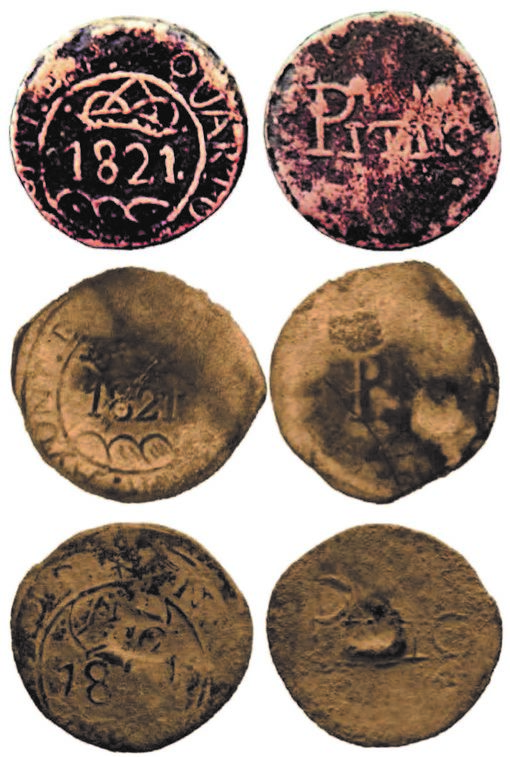
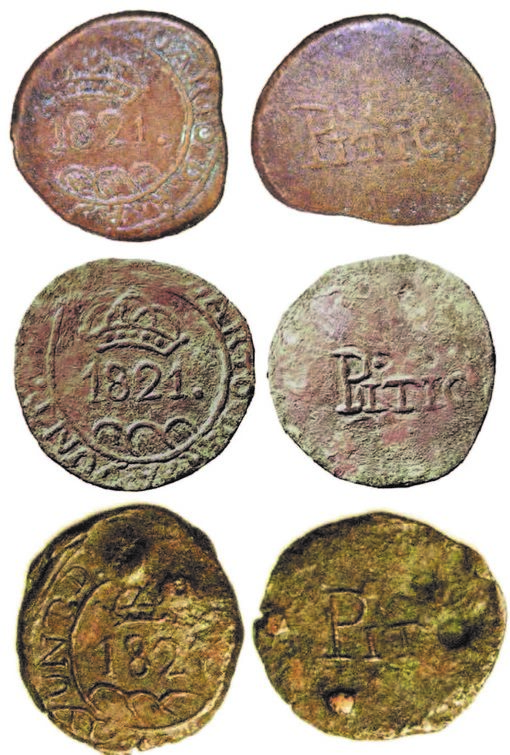
Best-known examples of the Sonora Jola 1821
Despite there being only eight specimens, different dies can be discriminated. There are significant variations in the size and alignment of numbers — clearly illustrated by the “21” being above one or two hills — and in the orientation of the legend relative to the central elements — one example clearly shows the letters “NT” (of “AYUNT.”) instead of “QUART” at the right side. Some small elements seem fused — as with the dots on the crown — suggesting die wear. The reverse shows only the word “PiTic.” with capitals only for “P” and “T”, in various sizes. In some examples, the dot at the end seems missing. Measurements from four examples indicated a range of 20 to 22mm in diameter, 1.3 to 1.75mm in thickness, 3.25 to 4.55gr in weight and plain edge.
The term “Jola” was commonly used in the 19th century throughout the northern provinces of New Spain (later, Mexico) to refer to all kind of small copper change in circulation. Dave Busse and Thomas Reid in Numismatic Terms of the República Mexicana described it as: a term for privately issued tradesman’s tokens. The Diccionario de Mexicanismos (Mexicanisms Dictionary) of 1895Feliz Ramos I. Duarte and Ricardo Gomez. Diccionario de Mexicanismos, 1st ed. 1895; 2nd ed. 1898, Mexico. says: Jola (chih.), af. money, coin. “Is a man of many jolas,” as for “Is a rich man” ...;... Jo (Sin.), sm. Cuartillo (coin valued at three cents of a peso); its second edition of 1898 reads: Jola (Dur.), sf. Peso, coin. In Chihuahua, people use jola for tlacos and cuartillos“jo” is short for “Jola”, “chih.” for “Chihuahua”, “Sin.” for Sinaloa” and “Dur.” for “Durango”. The word Jola (Joles or Jolas, plural) is an apheresis of the Latin word “Pecuniola” (small money), survivor of the Castilian Latin used by Jesuit missionaries of the northern provinces of New Spain, where the Latin “i” of “Iola” became a written consonant “J”Horacio Sobarzo. Vocabulario Sonorense, Instituto Sonorense de Cultura, Sonora, 1991.. While at least ten states, uncountable municipal governments and an endless number of trades (professions, stores, haciendas, bridges, plazas) struck copper coins locally throughout Mexico with diverse names and values — tlacos, señales, cacharpas, clacos, pilones, avitos, prietos, brujes, güitones, chavos, tanteos, tareas, chicas, fichas, butuchisAlberto Francisco Pradeau. Historia Numismática de México de 1823 a 1950, Tomo II. 1st. ed. Mexico, 1960. — some northerner towns in the 19th century seems to have favored the appellative “Jola”.
The term “Jola” is found in Northwestern American and Mexican newspapers. The Sacramento Daily Union of 12 January 1861 reads:
The Currency of Sonora.-- A correspondent of the Bulletin, writing from Hermosillo, Sonora, November 28th, says: Pesqueira is still here, and employed in arranging the momentous affairs of the “jolas,” which has occupied the undivided attention of the mercantile community for the last week. ...;... The alleged condition of the contract with the Mint, which will begin coining to-morrow, is the issue of $60,000 in jolas, at one dollar per pound.
The Sonora newspaper La Estrella de Occidente of 22 March 1867 reads:
The Jolas, Commerce and the poor. Hermosillo, March 20th 1867. The scarcity of Jolas is insufferable and even more with the low value commerce takes them ...;... Commerce is without a doubt the major tyrant oppressing the poor, and the copper coinage is a very good venue to dissimulate this tyranny. The big merchants speculate so much with the jolas, it makes me wish the government could remove them for good.
Early travelers of Mexico such as Josiah Gregg in his “Commerce of the Prairies (1831-1839)” Reuben Gold Thwaites. Early Western Travels 1748-1846, vol. II, Arthur H. Clark Company, Ohio, 1905. wrote:
The Mexican money table is as follows: 12 granos make I real; 8 reales, I peso, or dollar. These are the divisions used in computation, but instead of granos, the copper coins of Chihuahua and many other places, are the claco or jola (1/8 real) and the cuartilla (1/4 real).
In his classic article of 1999, James Ehrardt writes about another copper coin called Jola: The Texas Jola. Here a Spanish document describes how these Jolas were petitioned to the local authorities of the presidio of San Fernando de Bexar — capital of the colonial province of Texas in 1818:
This shall be the equivalent of the 2nd stamp of the Señor don Fernando the 7th, year of 1818. Senor Governor: don Jose Antonio de la Garza, Postmaster of this city, appears before your lordship and states that the extreme scarcity of small change which we are experiencing in this land results in a notable harm to the public. Inasmuch as I wish to provide for this lack in so far as my means will permit, I have decided to make up to the quantity of five hundred pesos of small change in copper coins called jolas, which shall circulate only through the town with values of one half of a real each. These shall be engraved with the first letters of my name and surname and the year of this date. For this purpose I shall give the necessary bonds on the terms your Lordship should order. I entreat your Lordship to be pleased to grant me the necessary permission, if there should be no just cause to hinder it, so that this may be carried out, and this money may circulate as soon as possible.
San Fernando de Bexar, November thirtieth of one thousand eight hundred and eighteen. Jose Antonio de Ia Garza.
Six Texas Jolas dating 1817 are known and about 100 dating 1818Mauricio Fernandez Garza. Las Monedas Municipales y su contexto historico, 2nd. ed. Mexico, 2014.. Despite their exclusive local appreciation, these Jolas circulated throughout the regions of the newly independent Mexican Republic. The first 1817 Texas Jola was discovered in the state of Guerrero in the 1960s. Other Texas Jolas have been found in Goliad (Texas).
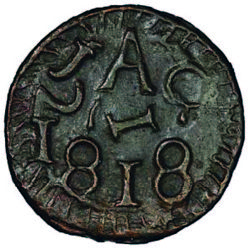
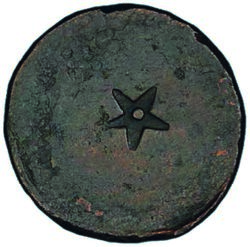
Texas Jola 1818 (1/2 real, José Antonio de la Garza initials [KMTn1])
[Heritage Auction #1298]
The “Statistical Memorial of the State of Occidente” published in 1828Pradeau. ibid. mentions another colonial Jola: In all the province of Sinaloa circulates, for the small traffic, the copper coinage made in Durango with the name of jolas or tlacos. These Jolas made at Durango are the copper Octavos we know today (1/8 real KM60) carrying dates from 1812 to 1818. José Antonio Juárez Muñoz, in his book Reseñas Históricas de la Casa de Moneda de Durango. 1811-1877 (Historical reviews of the Durango Mint), transcribes a fraction of a Spanish document regarding these Jolas:
In fulfillment of the order of your superiority of the 23rd of the current month requesting information about the matter of the Tlacos, here I provide with this letter a document showing the cost and gains that resulted from the 525 pesos that you ordered coined at the Mint under my charge; coins that were brought to the Caja Real, as I was able to verify on 26 February of this year, and got credited by the receipt of the ministers of the Royal Treasury. God save your superiority many years. Durango, 27 March 1813. Director. Manuel de Escárzega.
Juárez Muñoz extends on the matter based on another document found at the State Archives indicating that the government ordered the striking of 2,000 pesos more in copper Tlacos, coinage that was ultimately relocated to the Public Treasury of the city on 8 October 1813José Antonio Juárez Muñoz. Reseñas Históricas de la Casa de Moneda de Durango. 1811 - 1877, Conaculta, 2014.. If we consider the die-making process and striking time, the production of the 33,600 Jolas mentioned in February of 1813 might have started in 1812 (likely carrying that date). In contrast, the other 128,000 octavos finished before October of 1813 would correspond to Jolas carrying the date 1813.
Juárez Muñoz also transcribes a note — apparently from the same 1813 archive — indicating the shipment of provisional Durango coins to the mining center of Cosalá in the nearby state of Sinaloa: Provisional Mint, file regarding the packaging expenses for 10,000 pesos in coins, sent from this Caja Real to the one located at Cosalá. Durango Jolas — as called in Sinaloa — show a crowned monogram of King Fernando VII on the reverse and were produced under the Royalist governments of Don Bernando Bonavía (1813) and Don Alejo García Conde (1813 to 1817) Luis Navarro García. Los Intendentes de las provincias internas de Nueva España, Temas Americanistas, 2007.
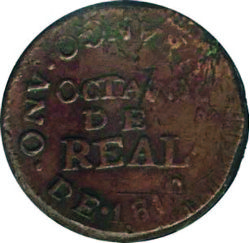
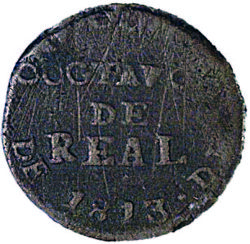
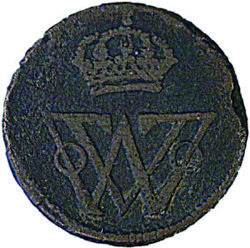
Durango Jolas years 1812 and 1813 ([KM60], 1/8 real)
Spanish documents authorizing the coinage of the Crowned Jola of Pitic 1821, remain to be found. At this point, we only know about their destruction in 1828 by the newly created state of Occidente. On 15 September 1828, the Occidente Legislature replaced the old name of the “Town of Pitic” with the new “City of Hermosillo”, in honor of the independence hero José María González HermosilloGilberto J. López Alanís. Diccionario de la Independencia en las Provincias de Sonora y Sinaloa (1800-1831). Sinaloa, 2010.; by 18 December 1828, Occidente issued a decree ordering the removal of old copper coinagePradeau. ibid.:
Supreme Government of the State of Occidente.- being currently minting copper Octavos ordered by the sovereign decree #49 of Congress issued on 23 February, in consequence to enable its legal circulation in the state of my command I have agreed on ordering the following precautions:
1a.- Starting ten days after the publication of this decree in each town of the State, all copper Octavos of Durango circulating here will be collected by the first local authorities affiliated to the Town councils.
2a.- Equal collection will be performed for those coins that have circulated with the title of Jolas in the city of Hermosillo, as well as any other coin of that kind introduced by other states. ...;
...
4a.- The quantities of collected coins will be exchanged with Octavos sent from this capital by the General Treasury to all administrations for its circulation.
5a.- Those copper Jolas and Octavos that have circulated until today in many towns of the State, considered false by the first local authorities in agreement with a special envoy to be named for this recognition, will not be exchanged and will be destroyed in the presence of all interested parties. ...
;...
God and Liberty. Concepcion of the Alamos (then the capital of Occidente), 19 December 1828. Jose Maria Gaxiola, Governor. Jose Francisco Velasco, Secretary.
Importantly, this decree called “Jolas” only those circulating at Hermosillo (Pitic), making a clear distinction from the “Octavos of Durango” and “any other coin of that kind introduced by other states”.
Despite lacking information, the only choice for a locally circulating jola at Hermosillo before 1828, is the Pitic Cuartilla of 1821 that we know today.
The current scarcity of Pitic Jolas suggests that most of them were gathered and melted down to make the new Octavos of Occidente in 1829. Evidently, this new republican government was keen on the prompt removal of all the offensive Royal coinage. Since Occidente Octavos [KM335] are smaller (17-18mm) and lighter (2-3gr) than Pitic Jolas, it is unlikely they were used as blanks for re-striking, as Chihuahua mint seems to have done with some Occidente Octavos in 1833 [DB510] Don Bailey. State and Federal copper and brass coinage of Mexico, 1824-1872. 2008.. From surviving specimens of the Sonora Jola we know that some of them circulated beyond 1828, and were demonetized by piercing or devaluated to 1/16 of a Real, as it happened to “Santoyo Cuartillas” [1832-1836, KM-364] after 23 July 1837Pradeau. Ibid..
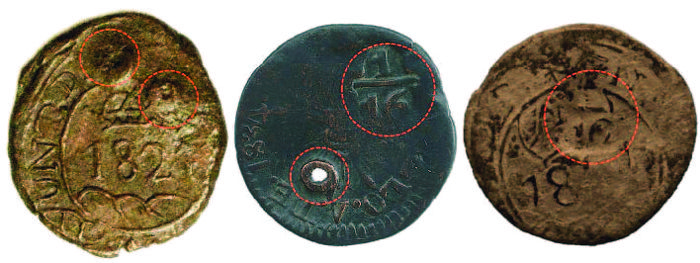
Demonetizing punches and 1/16 real devaluations on Pitic and Santoyo Cuartillas
Jose Francisco Velasco — the secretary that wrote the previous 1828 decree — chose his words carefully when addressing the inhabitants of Sonora; he distinguished “Hermosillo Jolas” from Durango octavos and other coins of the kind. According to Almada’s biographic dictionaryFrancisco R. Almada. Diccionario de Historia, Geografia y Biografia Sonorenses. Instituto Sonorense de Cultura. Sonora, 1990., Velasco was president of the municipal council of Pitic in 1821. Indeed, government acts of Pitic confirm Velasco was Constitutional Major in 1821: ...At the Presidio of Pitic on 17 March 1821, before me, Don José Francisco Velasco, Sub-Delegate of this Presidio and Constitutional Major of first vote, appeared Don Juan Guati, passerby merchant from Durango... ; ...At the Town of San Pedro of the Conquest of Pitic, on 24 April 1821, before me Don Francisco Velasco, Sub- Delegate and Constitutional Major of first voteFernando A. Galaz. Dejaron huella en el Hermosillo de ayer y hoy. Crónicas de Hermosillo de 1700 a 1967. , 2nd ed. Hermosillo, 1996.. Did Velasco witness or sanction the creation of these Jolas in 1821? We do not yet know but it seems he was especially aware of these Jolas and certainly not happy with them. In his Noticias Estadisticas del Estado de Sonora (Statistical News of the State of Sonora) of 1850, Velasco complained: The hardship offered by the Joles, that is the copper coinage, to commerce is by all means ruinous and without parallel.
Was the Sonora Jola issue by a Spanish Royalist authority or by an Independent pro-Bourbon First Mexican Empire? To answer we must consider that: 1) Velasco was municipal head of Pitic in 1821 and distinguished these Jolas in his decree of 1828; 2) Pitic publicly swore allegiance to the independence on 13 September 1821Nicolás Vidales Soto and Rina Cuellar Zazueta, La Independencia en las Provincias Internas de Occidente (Sonora y Sinaloa), Sinaloa, 2009; 3) the Imperial Gazette of 17 November 1821 decreed the election of provincial representatives to the Imperial Constituent Congress and the renewal of all municipal authorities by 24 November — accredited by the retiring authorities the same day; and 4) the new municipal authorities of Pitic had until 28 January 1822 to elect the provincial representatives to the Imperial congress. Everything indicates that this “crowned Cuartilla” of 1821 was issued under a still Spanish Royalist “War for Independence-period” municipal government. Of note, the Internal Occident Provinces of Sonora and Sinaloa elected Juan Miguel Riesgo (or Riezgo), Salvador Porrás, Manuel José Zuloaga and José Francisco VelascoJosé Luis Soberanes Fernández. The first Mexican Constituent congress, UNAM, 2012.
As in the cases of Texas and Durango, Sonora Jolas should have been a response to the local scarcity of fractional money — likely hastened by distance and road insecurity. It is not farfetched to imagine that any arrival of out-of-state Jolas would had inflicted not just a challenge to pride and economy but a reminder to local authorities of their right to strike copper money. The Village of Pitic was promoted to Town status on 29 August 1783Flavio Molina Molina. Historia de Hermosillo Antiguo, 1st ed. Hermosillo, 1983, and with that, the Monarchical Spanish Constitution — reinstated in June of 1820 — gave authority to its municipal government to procure its own fundingAlmada, op. cit.. By 15 September 1820, Pitic was showing new constitutional authorities: At this National Presidio of Pitic, before me Don Manuel Rodríguez, Constitutional Major of first vote... ; ...At the Presidio of Pitic Town of San Pedro of the Conquest, before me Ignacio Monroy, Constitutional Major of 2nd vote, this 26 of December of 1820F. A. Galáz, ibid.. Sonora Jolas should have been made at a local blacksmith’s workshop in Pitic, in the same way as hundreds of other towns and haciendas did throughout Mexico in the 19th century. The 35mm crude silver medals of Pitic — made to commemorate Iturbide’s ascension to the imperial throne of Mexico in 1822 — attest for the artisan capacity of this primitive mint of Pitic in 1821. Comparing two examples publicly knownFrank W. Grove. Medals of Mexico. vol II. 1972; Geo. W. Vogt. The Standard Catalog of Mexican Coins, Paper Money and Medals, 1978., the deciphered complete legend of the reverse reads at center: JURADO EN 6 DE OCTUbr. (Swore on 6 October); all around: MONVMENTO DE FELICIDAD DEL PITIC (Monument to the happiness of Pitic). The obverse at center has a crowned eagle standing over a nopal cactus and all around: AGVST. I. EMPERADOR D. MEXIC. 1822 (date reads upside down).
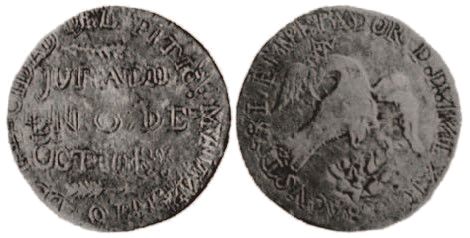
Grove 41a
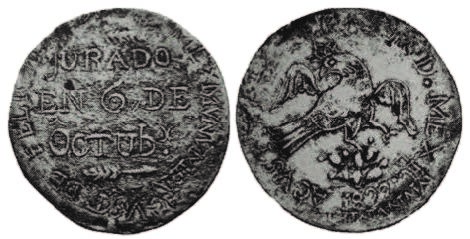
Vogt R-41
Interestingly, Jose Francisco Velasco — as part of the Imperial Constituent Congress — was one of the congressmen that urged Iturbide to seize the crown and later joined his National instituting CouncilFrancisco R. Almada, ibid.. He was at Pitic — acting as a lawyer and witnessF. A. Galáz, ibid. — at the time of Pitic’s ceremony swearing loyalty to Iturbide on 6 October 1822. Of note, there is a remarkable resemblance in the simplicity of designs and traces between the Crowns of:

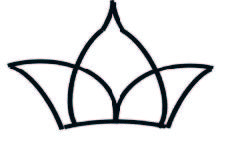
Royalist Pitic Jola 1821 Imperial Pitic Jola 1822
It has been argued that Pitic Jolas could have been ordered from the mint of Durango. This hypothesis has been supported by the fact that Leonardo Santoyo — who later opened the mints of Occidente (at Alamos in 1828) and Hermosillo (around 1831) — was commissioned by Pedro Celestino Negrete to restore the mint of Durango before 19 October 1821Pradeau, ibid., and was the fifth director of the mint acting from 1823 to 1824, just after Julián de la Barraza (1822) and Manuel de Escárzega (1813-1822)Juárez Muñoz, ibid.. Santoyo himself may have taken charge of destroying the royalist Jolas of Pitic and Durango to make his new republican 1828-29 Occidente Octavos in Alamos. If the manufacture of Santoyo Cuartillas is known to have required simple manual tools, as shown by the fact that they were heavily falsified in caves nearby Hermosillo — why could Pitic Jolas not be made at Pitic in a similar way?
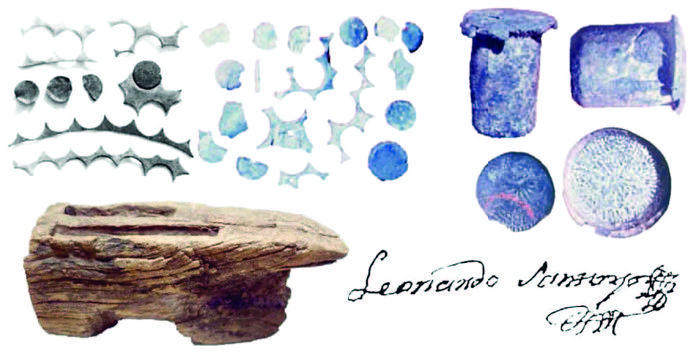
Metal scraps and tools to strike Santoyo Cuartillas found at Arbolillo's cave near Pitic (C.L.A.)
The municipal government of Pitic would have been better off by striking its coin locally instead of choosing economic dependence on another state, risking illegal overproduction and counterfeiting. While Juarez’s research on Durango mint archives did not produce evidence for Pitic, he did find documents relating to the creation of private Tlacos for José María Rivera in 1812, the Jolas of 1812-1818 and the New Viscaya coins of 1821-1823. Durango’s House of Representatives decided to order Imperial copper coins on 2 October 1821Juárez Muñoz, ibid.. These coins made at the Durango mint — with Santoyo’s help — carried an Imperial Crown over the arms of the province of New Viscaya.
Here is a last thought: Since Sonora and Sinaloa constituted a single colonial province in 1821, with its capital in Arizpe, and were not separated until 19 July 1823Flavio Molina Molina, ibid., should this Jola be also considered part of the numismatic history of Sinaloa?
